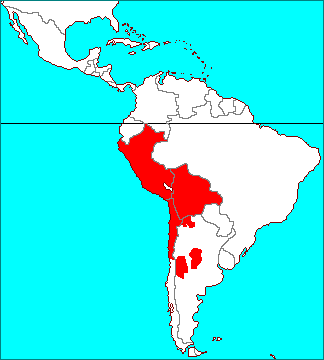
Peru, Bolivia, northern Chile, Argentina
Peru, Bolivia, northern Chile
Argentina (from Jujuy to Mendoza, Córdoba)
500 - 4,000 m elevation
Epiphytic, Saxicolous
Tillandsia virescens
Tillandsia (Diaphoranthema) virescens Ruiz and Pavon (1802)
- [ Etymology ] virescens in Latin (green-colored)
- Scapes are shorter than leaves, and the wide floral bracts are covered with trichomes. On the other hands, scapes of the standard Tillandsia capillaris are longer than leaves, and the floral bracts are glabrous.
- [ Width ] 20 mm
- [ Length ] 3 cm
- [ Petal ] Yellow
- [ Bract ] Brown
- [ Flower ] February - April
- [ Flower ] for 10 days
Classification
- [ Genus ] Tillandsia
- [ Subgenus ] Diaphoranthema
- [ Group ] capillaris
- [ Species ] virescens
- [ Synonyms ]
- Tillandsia capillaris Ruiz and Pavon (1802) forma cordobensis (Hieronyms) L. B. Smith (1935)
- Tillandsia capillaris Ruiz and Pavon (1802) forma virescens (Ruiz and Pavon) L. B. Smith (1935)
- Tillandsia cordobensis Hieronymus (1885)
- Tillandsia dependens Hieronymus (1896)
- Tillandsia dependens Hieronymus (1896) var. percordobensis Mez (1896)
- Tillandsia dependens Hieronymus (1896) forma percordobensis A. Castellanos (1933)
- Tillandsia dependens Hieronymus (1896) var. perusneoides Mez (1896)
- Tillandsia dependens Hieronymus (1896) forma perusneoides A. Castellanos (1933)
- Tillandsia dependens Hieronymus (1896) var. sanzinii Hicken (1914)
- Tillandsia propinqua Gay
- Tillandsia recurvata sensu Grisebach
- Tillandsia stolpi Philippi (1895)
- Tillandsia tomasii Halda (2005)
- Tillandsia virescens Ruiz and Pavon (1802) var. sanzinii (Hicken) A. Castellanos (1945)
- Tillandsia williamsii Rusby (1910)
Cultivation
Informations summarized here are based on our experiences, and TrekGEO does not guarantee the results by cultivating in the same or similar conditions described here. Even a species of Tillandsia differs substantially between individuals, and is very sensitive in changes of environments. Applicatons of any idea inspired by this site should be at your own risks.
3rd Plant
- Cultivation condition
- Partial shade, Long soaking, Shelving, Indoors
- Apr 2025 Good condition.
2nd Plant
- Cultivation condition
- Partial sun, Dipping, Shelving, AC / Heater
- Mar 2025 It keeps growing.
- Apr 2023 Capsules opened and seeds were scattered.
- Apr 2022 Capsules began to grow.
- Feb 2022 It flowered.
- Up to this point
- Partial sun, Long soaking, Shelving, AC / Heater
- Nov 2021 It keeps growing.
- Sep 2020 Good condition.
1st Plant
- Cultivation condition
- Partial shade, Long soaking, Shelving, Indoors
- Mar 2009 It keeps growing.
- Nov 2006 The bases of foliages were died. Only the growing points are alive.
- Oct 2006 Moved to another site. Cultivation condition is almost same as the previous site.
- Feb 2005 Yellow roots began to grow but it stopped growing in a month.
- Aug 2004 The temperature rises above 30 degree C for 40 days, and the highest temperature was over 39 degree C.
- Dec 2003 No outstanding changes.